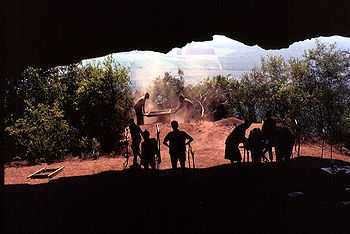Border Cave


Border Cave is a rock shelter on the western scarp of the Lebombo Mountains in KwaZulu-Natal near the border between South Africa and Swaziland. Border Cave has a remarkably continuous stratigraphic record of occupation spanning about 200 ka. Anatomically modern Homo sapiens skeletons together with stone tools and chipping debris were recovered. Dating by Carbon-14, amino acid racemisation and electron spin resonance places the oldest sedimentary ash at some 200 kiloannum.[1][2][3][4][5]
Excavations for guano in 1940 by a certain W. E. Barton of Swaziland, revealed a number of human bone fragments and were recognised as extremely old by Professor Raymond Dart, who had visited the site in July 1934, but had carried out only a superficial examination. In 1941 and 1942, a team sponsored by the University of the Witwatersrand carried out a more thorough survey. Subsequent excavations in the 1970s by Peter Beaumont were rewarded with rich yields. The site produced not only the complete skeleton of an infant, but also the remains of at least five adult hominins. Also recovered were more than 69,000 artifacts, and the remains of more than 43 mammal species, three of which are now extinct.[6]
Also recovered from the cave was the "Lebombo Bone", the oldest known artifact showing a counting tally. Dated to 35,000 years, it is a small piece of baboon fibula incised with 29 notches, similar to the calendar sticks used by the San of Namibia.[7] Animal remains from the cave show that its early inhabitants had a diet of bushpig, warthog, zebra and buffalo.[8] Raw materials used in the making of artifacts include chert, rhyolite, quartz, and chalcedony, as well as bone, wood and ostrich egg shells.
The west-facing cave, which is near Ingwavuma, is located about 100 m below the crest of the Lebombo range and commands sweeping views of the Swazi countryside below. It is semi-circular in horizontal section, some 40 m across, and formed in Jurassic lavas as a result of differential weathering.[9][10]
A set of tools almost identical to that used by the modern San people and dating to 44,000 BP were discovered at the cave in 2012. These represent the earliest unambiguous evidence for modern human behaviour.[11]
References
- ↑ Grün, Rainer; Beaumon, Peter (2001). "Border Cave revisited: a revised ESR chronology". Journal of Human Evolution 40 (6): 467–482. doi:10.1006/jhev.2001.0471. PMID 11371150.
- ↑ "Border Cave (South Africa)". archaeology.about.com. Retrieved 2010-01-14.
- ↑ Grün, R; Beaumont, PB; Stringer, CB (1990). "ESR dating evidence for early modern humans at Border Cave in South Africa". Nature 344 (6266): 537–539. doi:10.1038/344537a0. PMID 2157165.
- ↑ Bird, M.I.; Fifield, L.K.; Santos, G.M.; Beaumont, P.B.; Zhou, Y.; di Tada, M.L.; Hausladen, P.A. (2003). "Radiocarbon dating from 40 to 60 ka BP at Border Cave, South Africa". Quaternary Science Reviews 22 (8–9): 943–947. doi:10.1016/S0277-3791(03)00005-2.
- ↑ Cartmill, Matt; Smith, Fred H.; Brown, Kaye B. (2009-03-30). "Out of East Africa: Early Modern People in northern and southern Africa". The Human Lineage. John Wiley and Sons. ISBN 978-0-471-21491-5.
- ↑ Cooke, H. B. S.; Malan, B. D.; H. Wells, L. (1945). "Fossil Man in the Lebombo Mountains, South Africa: The 'Border Cave,' Ingwavuma District, Zululand". Man 45: 6–13. doi:10.2307/2793006. JSTOR 2793006.
- ↑ Darling, David J. (2004). The universal book of mathematics: from Abracadabra to Zeno's paradoxes. John Wiley and Sons. ISBN 978-0-471-27047-8.
- ↑ "Border Cave opens for visitors". southafrica.info. 15 January 2004. Retrieved 2010-01-14.
- ↑ Border Cave (PDF). Google Docs. Retrieved 2010-01-14.
- ↑ Butzer, K. W.; Beaumont, P. B.; Vogel, J. C. (1978). "Lithostratigraphy of Border Cave KwaZulu, South Africa: a Middle Stone Age Sequence Beginning c. 195,000 B.P". Journal of Archeological Science 5 (4): 317–341. doi:10.1016/0305-4403(78)90052-3.
- ↑ Earliest' evidence of modern human culture found, Nick Crumpton, BBC News, 31 July 2012
External links
| Wikimedia Commons has media related to Border Cave. |
- Discovering The Deep African Past at Wonderwerk Cave - Peter Beaumont & John Vogel
- Unesco World Heritage listing for Pleistocene occupation sites of Klasies River, Border Cave, Wonderwerk Cave and comparable sites relating to the emergence of modern humans
Coordinates: 27°01′33″S 31°59′20″E / 27.02583°S 31.98889°E